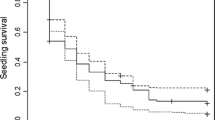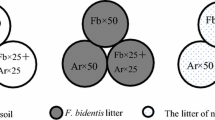Abstract
Background and aims
Through recruitment, plants establish in novel environments. Recruitment also is the stage where plants undergo the highest mortality. We investigate the recruitment niche for Microstegium vimineum, an annual grass from East Asia spreading throughout eastern North American forests.
Methods
Current observational and greenhouse research indicates that M. vimineum recruitment may be inhibited by leaf litter and promoted by soil moisture; we use field studies to experimentally test how these factors influence M. vimineum germination, seedling survival and reproduction. Specifically, we introduce M. vimineum seeds into forest microhabitats with experimentally varied levels of soil moisture and leaf litter.
Results
Soil moisture increases M. vimineum germination regardless of leaf litter thickness and ameliorates seedling mortality in deep leaf litter. Seed production per m2 increases with watering, reflecting higher germination and survival, whereas per capita seed production increases with leaf litter thickness, reflecting density-dependent limits on seed production.
Conclusions
The interactive effects of varied levels of soil moisture and leaf litter thickness on key M. vimineum life history stages highlight the need to consider multiple drivers, such as rainfall and local forest disturbance, when assessing how soil properties influence the establishment of invasive plants.




Similar content being viewed by others
References
Akaike H (1973) Information theory as an extension of the maximum likelihood principle. In: Petrov BN, Csaki F (eds) Second International Symposium on Information Theory. Akademiai Kiado, Budapest, pp 267–281
Albrecht MA, McCarthy BC (2009) Seedling establishment shapes the distribution of shade-adapted forest herbs across a topographical moisture gradient. J Ecol 97:1037–1049
Bates D, Maechler M (2009) Linear mixed-effects models using S4 classes. R package version 2.14.1
Bazzaz FA, Ackerly DD, Reekie EG (2000) Reproductive allocation in plants. In: Fenner M (ed) Seeds: The Ecology of Regeneration in Plant Communities. CABI Publishing, Wallingford
Belote RT, Jones RH (2009) Tree leaf litter composition and nonnative earthworms influence plant invasion in experimental forest floor mesocosms. Biol Invasions 11:1045–1052
Bolker BM, Brooks ME, Clark CJ, Geange SW, Poulsen JR, Stevens MH, White JS (2009) Generalized linear mixed models: a practical guide for ecology and evolution. Trends Ecol Evol 24:127–135
Boyd N, Van Acker R (2004) Seed germination of common weed species as affected by oxygen concentration, light, and osmotic potential. Weed Sci 52:589–596
Cheplick GP (2005) Biomass partitioning and reproductive allocation in the invasive, cleistogamous grass Microstegium vimineum: influence of the light environment. J Torrey Bot Soc 132:214–224
Cheplick GP (2006) A modular approach to biomass allocation in an invasive annual (Microstegium vimineum; Poaceae). Am J Bot 93:539–545
Cheplick GP (2007) Plasticity of chasmogamous and cleistogamous reproductive allocation in grasses. Aliso 23:286–294
Cheplick GP (2010) Limits to local spatial spread in a highly invasive annual grass (Microstegium vimineum). Biol Invasions 12:1759–1771
Chesson P, Gebauer RLE, Schwinning S, Huntly N, Wiegand K, Ernest MSK, Sher A, Novoplansky A, Weltzin JF (2004) Resource pulses, species interactions, and diversity maintenance in arid and semi-arid environments. Oecologia 141:236–253
Christen DC, Matlack GR (2009) The habitat and conduit functions of roads in the spread of three invasive plant species. Biol Invasions 11:453–465
Claridge K, Franklin SB (2002) Compensation and plasticity in an invasive plant species. Biol Invasions 4:339–347
Clark JS, Macklin E, Wood L (1998) Stages and spatial scales of recruitment limitation in southern Appalachian forests. Ecol Monogr 68:213–235
Cole PG, Weltzin JF (2004) Environmental correlates of the distribution and abundance of Microstegium vimineum, in east Tennessee. Southeast Nat 3:545–562
Cole PG, Weltzin JF (2005) Light limitation creates patchy distribution of an invasive grass in eastern deciduous forests. Biol Invasions 7:477–488
Development Core Team R (2012) R: A language and environment for statistical computing. R Foundation for Statistical Computing, Vienna
Droste T, Flory SL, Clay K (2010) Variation for phenotypic plasticity among populations of an invasive exotic grass. Plant Ecol 207:297–306
Ehrenfeld JG, Kourtev P, Huang WZ (2001) Changes in soil functions following invasions of exotic understory plants in deciduous forests. Ecol Appl 11:1287–1300
Elgersma KJ, Yu S, Vor T, Ehrenfeld JG (2012) Microbial-mediated feedbacks of leaf litter on invasive plant growth and interspecific competition. Plant Soil 356:341–355
Elston DA, Moss R, Boulinier T, Arrowsmith C, Lambin X (2001) Analysis of aggregation, a worked example: numbers of ticks on red grouse chicks. Parasitology 122:563–569
Engelbrecht BMJ, Dalling JW, Pearson TRH, Wolf RL, Galvez DA, Koehler T, Tyree MT, Kursar TA (2006) Short dry spells in the wet season increase mortality of tropical pioneer seedlings. Oecologia 148:258–269
Eschtruth AK, Battles JJ (2009) Acceleration of exotic plant invasion in a forested ecosystem by a generalist herbivore. Conserv Biol 23:388–399
Evans CE, Etherington JR (1990) The effect of soil-water potential on seed-germination of some British plants. New Phytol 115:539–548
Evans CE, Etherington JR (1991) The effect of soil-water potential on seedling growth of some British plants. New Phytol 118:571–579
Evans MEK, Ferriere R, Kane MJ, Venable DL (2007) Bet hedging via seed banking in desert evening primroses (Oenothera, Onagraceae): demographic evidence from natural populations. Am Nat 169:184–194
Flory SL, Rudgers JA, Clay K (2007) Experimental light treatments affect invasion success and the impact of Microstegium vimineum on the resident community. Nat Areas J 27:124–132
Flory SL, Long F, Clay K (2011) Invasive Microstegium populations consistently outperform native range populations across diverse environments. Ecology 92:2248–2257
Gallagher RS, Fuerst EP (2006) The ecophysiological basis of weed seed longevity in the soil. In: Basra A (ed) Handbook of seed science and technology. Haworth Press, Inc., Binghamton, pp 521–557
Gibson DJ, Spyreas G, Benedict J (2002) Life history of Microstegium vimineum (Poaceae), an invasive grass in southern Illinois. J Torrey Bot Soc 129:207–219
Glasgow LS, Matlack GR (2007) The effects of prescribed burning and canopy openness on establishment of two non-native plant species in a deciduous forest, southeast Ohio, USA. For Ecol Manag 238:319–329
Grubb PJ (1977) Maintenance of species-richness in plant communities - importance of regeneration niche. Biological Reviews 52:107–145
Harper JL (1977) Population biology of plants. Academic, New York
Horton JL, Neufeld HS (1998) Photosynthetic responses of Microstegium vimineum (Trin.) A. Camus, a shade-tolerant, C-4 grass, to variable light environments. Oecologia 114:11–19
Hurlbert SH, Lombardi CM (2009) Final collapse of the Newman-Pearson decision theoretic framework and the rise of the neoFisherian. Ann Zool Fenn 46:311–349
Judge CA (2008) Japanese stiltgrass (Microstegium vimineum) management for restoration of native plant communities. Invasive Plant Sci Manag 1:111–119
Kourtev PS, Ehrenfeld JG, Huang WZ (1998) Effects of exotic plant species on soil properties in hardwood forests of New Jersey. Water Air Soil Pollut 105:493–501
Kourtev PS, Ehrenfeld JG, Haggblom M (2002a) Exotic plant species alter the microbial community structure and function in the soil. Ecology 83:3152–3166
Kourtev PS, Ehrenfeld JG, Huang WZ (2002b) Enzyme activities during litter decomposition of two exotic and two native plant species in hardwood forests of New Jersey. Soil Biol Biochem 34:1207–1218
Lambers HF, Chapin SI, Pons TL (1998) Plant physiological ecology. Springer, New York
Marshall JM, Buckley DS (2008) Influence of litter removal and mineral soil disturbance on the spread of an invasive grass in a Central Hardwood forest. Biol Invasions 10:531–538
Moles AT, Warton DI, Westoby M (2003) Seed size and survival in the soil in arid Australia. Aust Ecol 28:575–585
Morgan MT (2001) Consequences of life history for inbreeding depression and mating system evolution in plants. Proc R Soc B-Biol Sci 268:1817–1824
Morrison JA, Lubchansky HA, Mauck KE, McCartney KM, Dunn B (2007) Ecological comparison of two co-invasive species in eastern deciduous forests: Alliaria petiolata and Microstegium vimineum. J Torrey Bot Soc 134:1–17
Nagy C, Aschen S, Christie R, Weckel M (2011) Japanese stilt grass (Microstegium vimineum), a nonnative invasive grass, provides alternative habitat for native frogs in a suburban forest. Urban Habitats 6
Oswalt CM, Oswalt SN (2007) Winter litter disturbance facilitates the spread of the nonnative invasive grass Microstegium vimineum (Trin.) A. Camus. For Ecol Manag 249:199–203
Padilla FM, Miranda JD, Pugnaire FI (2007) Early root growth plasticity in seedlings of three Mediterranean woody species. Plant Soil 296:103–113
Schramm JW, Ehrenfeld JG (2010) Leaf litter and understory canopy shade limit the establishment, growth and reproduction of Microstegium vimineum. Biol Invasions 12:3195–3204
Warren RJ, Bradford MA (2011) The shape of things to come: woodland herb niche contraction begins during recruitment in mesic forest microhabitat. Proc R Soc B-Biol Sci 278:1390–1398
Warren RJ, Bahn V, Kramer T, Tang Y, Bradford MA (2011a) Performance and reproduction of an exotic invader across temperate forest gradients. Ecosphere 2:1–19
Warren RJ, Wright JP, Bradford MA (2011b) The putative niche requirements and landscape dynamics of Microstegium vimineum – an invasive Asian grass. Biol Invasions 13:471–483
Warren RJ, Bahn V, Bradford MA (2012) The interaction between propagule pressure, habitat suitability and density-dependent reproduction in species invasion. Oikos 121:874–881
Webster CR, Rock JH, Froese RE, Jenkins MA (2008) Drought-herbivory interaction disrupts competitive displacement of native plants by Microstegium vimineum, 10-year results. Oecologia 157:497–508
Xiong SJ, Nilsson C (1999) The effects of plant litter on vegetation: a meta-analysis. J Ecol 87:984–994
Zuur AF, Ieno EN, Smith GM (2007) Analyzing ecological data. Spring, New York
Acknowledgments
This research was supported by National Science Foundation grants DEB-0823293 and DEB-0218001 to the Coweeta LTER Program. We appreciate input from two anonymous reviewers that improved the manuscript.
Author information
Authors and Affiliations
Corresponding author
Additional information
Responsible Editor: T. Kalapos.
Rights and permissions
About this article
Cite this article
Warren, R.J., Bahn, V. & Bradford, M.A. Decoupling litter barrier and soil moisture influences on the establishment of an invasive grass. Plant Soil 367, 339–346 (2013). https://doi.org/10.1007/s11104-012-1477-z
Received:
Accepted:
Published:
Issue Date:
DOI: https://doi.org/10.1007/s11104-012-1477-z




